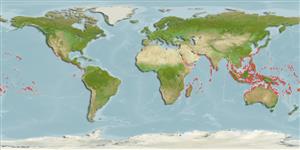Actinopterygii (peixes com raios nas barbatanas) >
Perciformes (Perch-likes) >
Carangidae (Jacks and pompanos) > Trachinotinae
Etymology: Trachinotus: Greek, trachys, -eia, -ys = rough + Greek,noton = back (Ref. 45335).
Ambiente / Clima / Intervalo
Ecologia
; marinhas; estuarina associadas(os) a recifes; intervalo de profundidade 1 - 7 m (Ref. 5439). Tropical, preferred 28°C (Ref. 107945); 32°N - 32°S
Indo-Pacific: Red Sea and East Africa (Ref. 3287) to the Marshall Islands and Samoa, north to southern Japan, south to Australia.
Length at first maturity / Tamanho / Peso / Idade
Maturity: Lm ?, range 58 - ? cm
Max length : 110 cm FL macho/indeterminado; (Ref. 1602); common length : 40.0 cm TL macho/indeterminado; (Ref. 3280); Peso máx. publicado: 3.4 kg (Ref. 40637)
Espinhos dorsais (total): 7; Raios dorsais (total): 18-20; Espinhos anais 3; Raios anais : 16 - 18.
Juveniles inhabit sandy shorelines and shallow sandy or muddy bays near river mouths while adults move out in schools to clear seaward coral and rock reefs (Ref. 5213). Juveniles are in small schools, while adults are usually solitary (Ref. 48635). Adults feed primarily on sand mollusks and other hard-shelled invertebrates (Ref. 9710).
Life cycle and mating behavior
Maturidade | Reprodução | Desova | Ovos | Fecundidade | Larvas
Paxton, J.R., D.F. Hoese, G.R. Allen and J.E. Hanley, 1989. Pisces. Petromyzontidae to Carangidae. Zoological Catalogue of Australia, Vol. 7. Australian Government Publishing Service, Canberra, 665 p. (Ref. 7300)
Status na Lista Vermelha da IUCN (Ref. 115185)
CITES (Ref. 94142)
Not Evaluated
Perigo para os humanos
Reports of ciguatera poisoning (Ref. 30911)
Uso pelos humanos
Pescarias: pouco comercial; Aquacultura: espécies comerciais; peixe esportivo: sim; Aquário: Aquários públicos
Ferramentas
Relatórios especiais
Baixar XML
Fontes da internet
